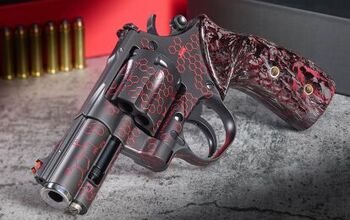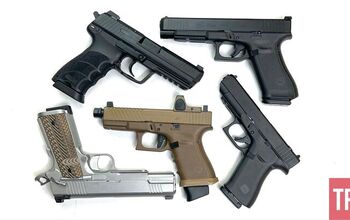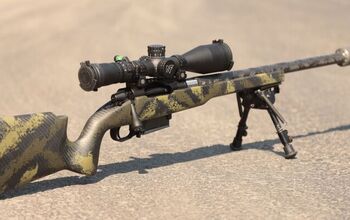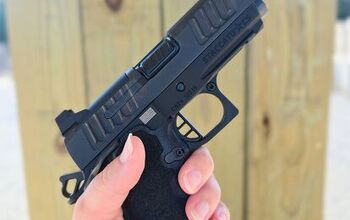Wheelgun Wednesday: Auto Or Revolver - Why Not Both?

Auto-loading pistols rule the roost in the handgun world these days, with revolvers in second place—but that wasn’t always the case. As the 1800s turned into the 1900s, autoloaders were just coming on the scene, but revolvers had decades of established reliability behind them. So what if you wanted the advantages of an auto, but the reliability of a revolver? In the Webley-Fosbery auto revolver, you had an attempt to combine both.
Webley handguns @ TFB:
Transitional species
The Webley-Fosbery could easily have been a Colt-Fosbery. When Lieutenant Colonel George Vincent Fosbery invented a mechanism that would cock a revolver’s hammer and rotate the cylinder for the shooter. Fosbery had a military career marked by bravery in bad spots—he won a Victoria Cross in the Umbeyla Campaign in 1863, so he knew the importance of having a fast-shooting, reliable weapon. He retired from the military in 1877, but he kept busy—he is credited for inventing the Paradox Gun in 1885. This gave shooters a double-barreled gun that could function as a shotgun but fill in for a rifle in a pinch. Maybe not something the average hunter would want, but something that a British officer posted overseas might want.
Then, in 1895, he patented an auto-cocking revolver design. He grafted his system onto a Colt Peacemaker first, but it was Webley & Scott that bought the design. They took the plans and made the Webley-Fosbery Automatic Revolver.
There were other auto revolvers on the market then and now, but they were oddities, and that certainly described the Webley-Fosbery Automatic Revolver. To fire the handgun, the shooter first had to cock the hammer, just like every other single-action revolver. Pulling the trigger dropped the hammer, just like every other single-action revolver—and then things got weird.
The Webley-Fosbery used the recoil from firing the cartridge to move the whole top half of the gun backwards, like the slide on a Colt 1911. As this was happening, the hammer re-cocked and the cylinder advanced. Striations on the cylinder moved it half-a-step around; then the top half of the gun returned to battery, the cylinder went the other half-a-step and had the next cartridge lined up and ready to shoot. Pull the trigger (a light, single-action pull) and the process repeated itself. Repeat until you had fired all six shots.
Or, repeat until you’d fired all eight shots. Most of the Webley-Fosbery revolvers came chambered in .455 Webley, as that was the British service cartridge for handguns at that time, and Webley wanted to capture the military market. This version of the gun was a six-shooter.
However, there was also a version of the revolver chambered in .38 ACP that came with an eight-shot cylinder, and this revolver also came with speedloaders. With its break-top action and that speedloader, this version of the Webley-Fosbery would have been very quick to reload when compared to most other revolvers of that era. Speedloaders were not common in the days before World War I, although the Webley-Fosbery was not the first gun to have them available.
Sales slump
The total number of Webley-Fosbery revolvers produced was around 5,000, including both calibers. Why was this oddball revolver not a success? There are probably a few reasons. First, it was expensive, with the price in Great Britain starting at 110 shillings before World War I, when a standard Webley set you back 86 shillings (the government price for military purchase was 69 shillings). And for a laborer, that Webley-Fosbery might set you back a whole month’s wages, so it wasn’t like Average Joes were going to buy these for backyard plinking.
While the Webley-Fosbery did see some private sales to army officers, the mud of World War I reputedly gummed up the cylinder mechanism. That was bad for business, especially repeat business. Other soldiers outside the trenches were said to be happy with these revolvers, though, particularly aviators. In those days, pilots of early warplanes were taking potshots at each other with revolvers and rifles until the wonks in engineering figured out how to effectively mount machine guns to their cockpits.
After the war, Webley kept on making these revolvers, stopping production in the mid-1920s and carrying unsold models in their catalogs until the late 1930s.
As this is just an overview of the weapon, if you’re really curious, Ian McCollum from Forgotten Weapons has not just a good deep dive into the Webley-Fosberry, but several good videos on its operation here.
This revolver here
The revolver seen in the photos here is for sale by Joe Salter, with an asking price of a very cool $16,995. However, it is not only an ultra-rare revolver, it also comes with provenance that it belonged to Edward Gunner, a British military officer—a gunner, actually—who served in the late 1800s, returning for World War I. See more details and more photos here.
























Comments
Join the conversation
It even got a mention in The Maltese Falcon.
If I could have one revolver in the world it would probably be this one.